Hieu Le
Learning to Weight Parameters for Data Attribution
Jun 06, 2025


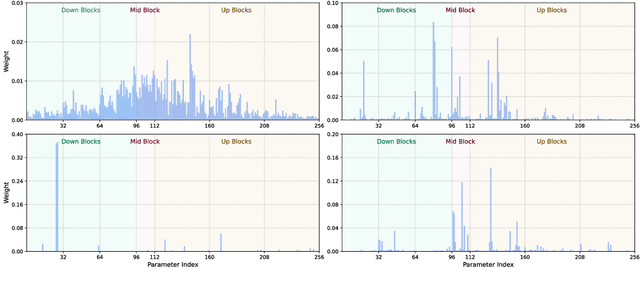
Abstract:We study data attribution in generative models, aiming to identify which training examples most influence a given output. Existing methods achieve this by tracing gradients back to training data. However, they typically treat all network parameters uniformly, ignoring the fact that different layers encode different types of information and may thus draw information differently from the training set. We propose a method that models this by learning parameter importance weights tailored for attribution, without requiring labeled data. This allows the attribution process to adapt to the structure of the model, capturing which training examples contribute to specific semantic aspects of an output, such as subject, style, or background. Our method improves attribution accuracy across diffusion models and enables fine-grained insights into how outputs borrow from training data.
Improving Contrastive Learning for Referring Expression Counting
May 28, 2025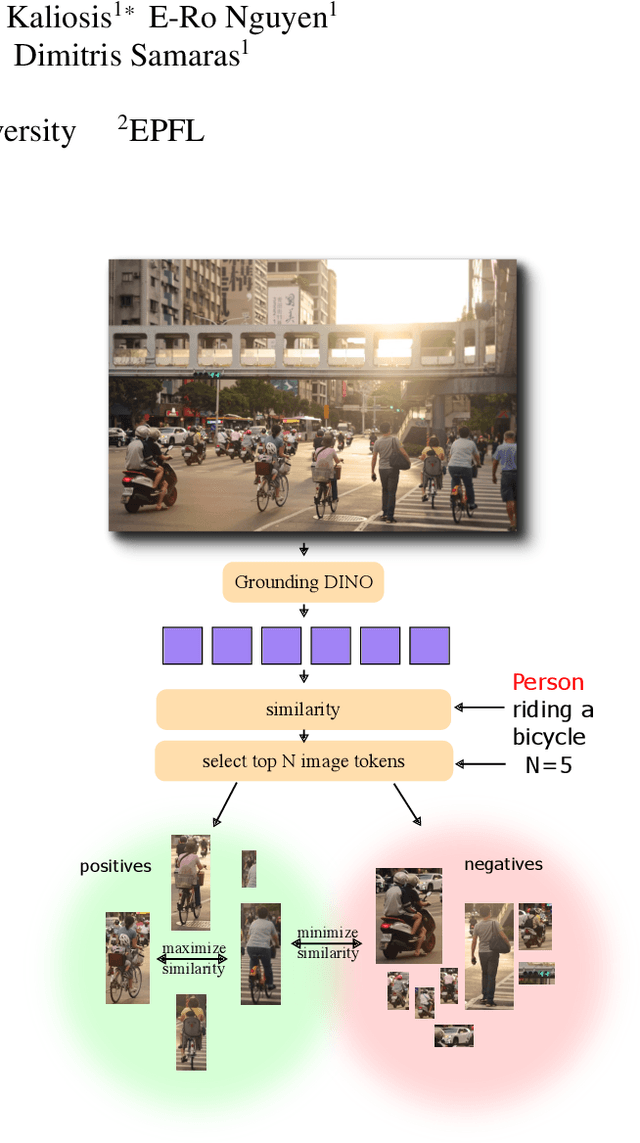
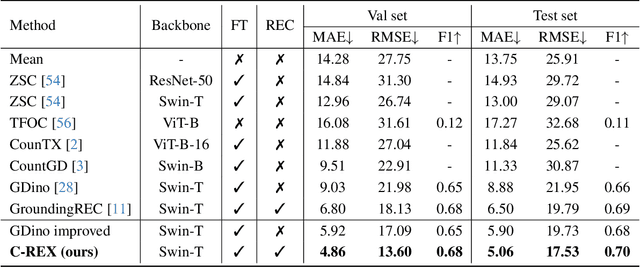
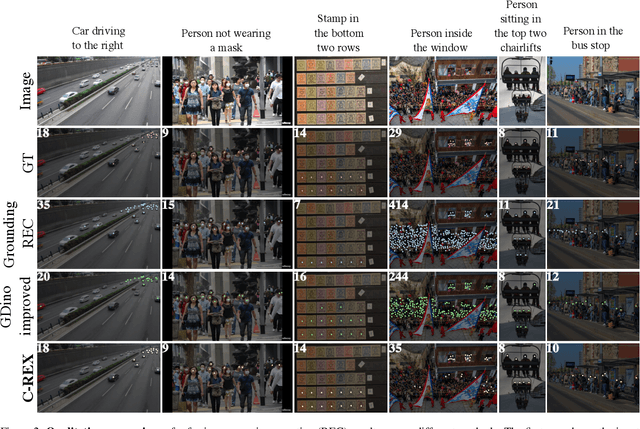
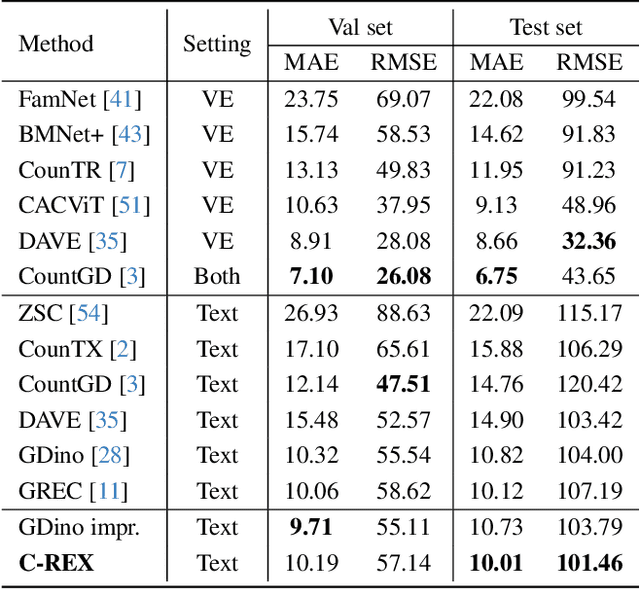
Abstract:Object counting has progressed from class-specific models, which count only known categories, to class-agnostic models that generalize to unseen categories. The next challenge is Referring Expression Counting (REC), where the goal is to count objects based on fine-grained attributes and contextual differences. Existing methods struggle with distinguishing visually similar objects that belong to the same category but correspond to different referring expressions. To address this, we propose C-REX, a novel contrastive learning framework, based on supervised contrastive learning, designed to enhance discriminative representation learning. Unlike prior works, C-REX operates entirely within the image space, avoiding the misalignment issues of image-text contrastive learning, thus providing a more stable contrastive signal. It also guarantees a significantly larger pool of negative samples, leading to improved robustness in the learned representations. Moreover, we showcase that our framework is versatile and generic enough to be applied to other similar tasks like class-agnostic counting. To support our approach, we analyze the key components of sota detection-based models and identify that detecting object centroids instead of bounding boxes is the key common factor behind their success in counting tasks. We use this insight to design a simple yet effective detection-based baseline to build upon. Our experiments show that C-REX achieves state-of-the-art results in REC, outperforming previous methods by more than 22\% in MAE and more than 10\% in RMSE, while also demonstrating strong performance in class-agnostic counting. Code is available at https://github.com/cvlab-stonybrook/c-rex.
Few-shot Personalized Scanpath Prediction
Apr 07, 2025Abstract:A personalized model for scanpath prediction provides insights into the visual preferences and attention patterns of individual subjects. However, existing methods for training scanpath prediction models are data-intensive and cannot be effectively personalized to new individuals with only a few available examples. In this paper, we propose few-shot personalized scanpath prediction task (FS-PSP) and a novel method to address it, which aims to predict scanpaths for an unseen subject using minimal support data of that subject's scanpath behavior. The key to our method's adaptability is the Subject-Embedding Network (SE-Net), specifically designed to capture unique, individualized representations for each subject's scanpaths. SE-Net generates subject embeddings that effectively distinguish between subjects while minimizing variability among scanpaths from the same individual. The personalized scanpath prediction model is then conditioned on these subject embeddings to produce accurate, personalized results. Experiments on multiple eye-tracking datasets demonstrate that our method excels in FS-PSP settings and does not require any fine-tuning steps at test time. Code is available at: https://github.com/cvlab-stonybrook/few-shot-scanpath
AutoLike: Auditing Social Media Recommendations through User Interactions
Feb 13, 2025Abstract:Modern social media platforms, such as TikTok, Facebook, and YouTube, rely on recommendation systems to personalize content for users based on user interactions with endless streams of content, such as "For You" pages. However, these complex algorithms can inadvertently deliver problematic content related to self-harm, mental health, and eating disorders. We introduce AutoLike, a framework to audit recommendation systems in social media platforms for topics of interest and their sentiments. To automate the process, we formulate the problem as a reinforcement learning problem. AutoLike drives the recommendation system to serve a particular type of content through interactions (e.g., liking). We apply the AutoLike framework to the TikTok platform as a case study. We evaluate how well AutoLike identifies TikTok content automatically across nine topics of interest; and conduct eight experiments to demonstrate how well it drives TikTok's recommendation system towards particular topics and sentiments. AutoLike has the potential to assist regulators in auditing recommendation systems for problematic content. (Warning: This paper contains qualitative examples that may be viewed as offensive or harmful.)
Signal Whisperers: Enhancing Wireless Reception Using DRL-Guided Reflector Arrays
Jan 25, 2025



Abstract:This paper presents a novel approach for enhancing wireless signal reception through self-adjustable metallic surfaces, termed reflectors, which are guided by deep reinforcement learning (DRL). The designed reflector system aims to improve signal quality for multiple users in scenarios where a direct line-of-sight (LOS) from the access point (AP) and reflector to users is not guaranteed. Utilizing DRL techniques, the reflector autonomously modifies its configuration to optimize beam allocation from the AP to user equipment (UE), thereby maximizing path gain. Simulation results indicate substantial improvements in the average path gain for all UEs compared to baseline configurations, highlighting the potential of DRL-driven reflectors in creating adaptive communication environments.
MedTet: An Online Motion Model for 4D Heart Reconstruction
Dec 03, 2024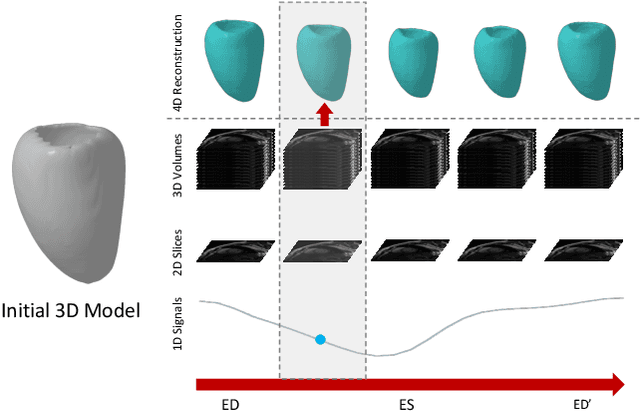

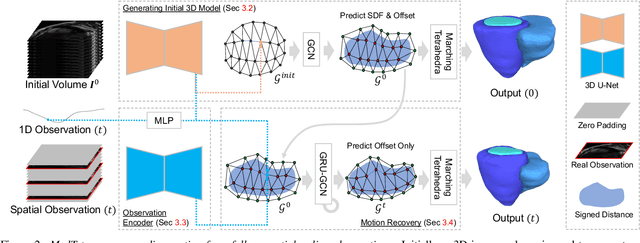
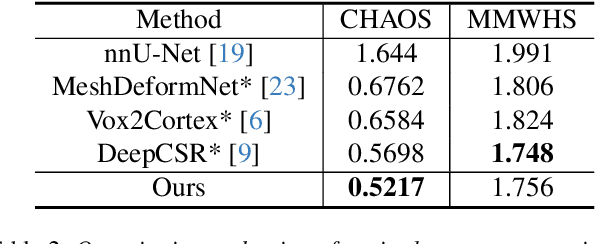
Abstract:We present a novel approach to reconstruction of 3D cardiac motion from sparse intraoperative data. While existing methods can accurately reconstruct 3D organ geometries from full 3D volumetric imaging, they cannot be used during surgical interventions where usually limited observed data, such as a few 2D frames or 1D signals, is available in real-time. We propose a versatile framework for reconstructing 3D motion from such partial data. It discretizes the 3D space into a deformable tetrahedral grid with signed distance values, providing implicit unlimited resolution while maintaining explicit control over motion dynamics. Given an initial 3D model reconstructed from pre-operative full volumetric data, our system, equipped with an universal observation encoder, can reconstruct coherent 3D cardiac motion from full 3D volumes, a few 2D MRI slices or even 1D signals. Extensive experiments on cardiac intervention scenarios demonstrate our ability to generate plausible and anatomically consistent 3D motion reconstructions from various sparse real-time observations, highlighting its potential for multimodal cardiac imaging. Our code and model will be made available at https://github.com/Scalsol/MedTet.
Enhancing Compositional Text-to-Image Generation with Reliable Random Seeds
Dec 02, 2024Abstract:Text-to-image diffusion models have demonstrated remarkable capability in generating realistic images from arbitrary text prompts. However, they often produce inconsistent results for compositional prompts such as "two dogs" or "a penguin on the right of a bowl". Understanding these inconsistencies is crucial for reliable image generation. In this paper, we highlight the significant role of initial noise in these inconsistencies, where certain noise patterns are more reliable for compositional prompts than others. Our analyses reveal that different initial random seeds tend to guide the model to place objects in distinct image areas, potentially adhering to specific patterns of camera angles and image composition associated with the seed. To improve the model's compositional ability, we propose a method for mining these reliable cases, resulting in a curated training set of generated images without requiring any manual annotation. By fine-tuning text-to-image models on these generated images, we significantly enhance their compositional capabilities. For numerical composition, we observe relative increases of 29.3% and 19.5% for Stable Diffusion and PixArt-{\alpha}, respectively. Spatial composition sees even larger gains, with 60.7% for Stable Diffusion and 21.1% for PixArt-{\alpha}.
Counting Stacked Objects from Multi-View Images
Nov 28, 2024


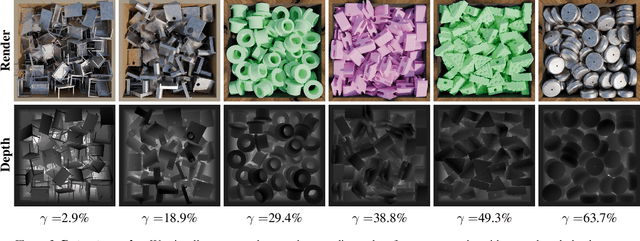
Abstract:Visual object counting is a fundamental computer vision task underpinning numerous real-world applications, from cell counting in biomedicine to traffic and wildlife monitoring. However, existing methods struggle to handle the challenge of stacked 3D objects in which most objects are hidden by those above them. To address this important yet underexplored problem, we propose a novel 3D counting approach that decomposes the task into two complementary subproblems - estimating the 3D geometry of the object stack and the occupancy ratio from multi-view images. By combining geometric reconstruction and deep learning-based depth analysis, our method can accurately count identical objects within containers, even when they are irregularly stacked. We validate our 3D Counting pipeline on diverse real-world and large-scale synthetic datasets, which we will release publicly to facilitate further research.
Importance-based Token Merging for Diffusion Models
Nov 23, 2024



Abstract:Diffusion models excel at high-quality image and video generation. However, a major drawback is their high latency. A simple yet powerful way to speed them up is by merging similar tokens for faster computation, though this can result in some quality loss. In this paper, we demonstrate that preserving important tokens during merging significantly improves sample quality. Notably, the importance of each token can be reliably determined using the classifier-free guidance magnitude, as this measure is strongly correlated with the conditioning input and corresponds to output fidelity. Since classifier-free guidance incurs no additional computational cost or requires extra modules, our method can be easily integrated into most diffusion-based frameworks. Experiments show that our approach significantly outperforms the baseline across various applications, including text-to-image synthesis, multi-view image generation, and video generation.
Instance-Aware Generalized Referring Expression Segmentation
Nov 22, 2024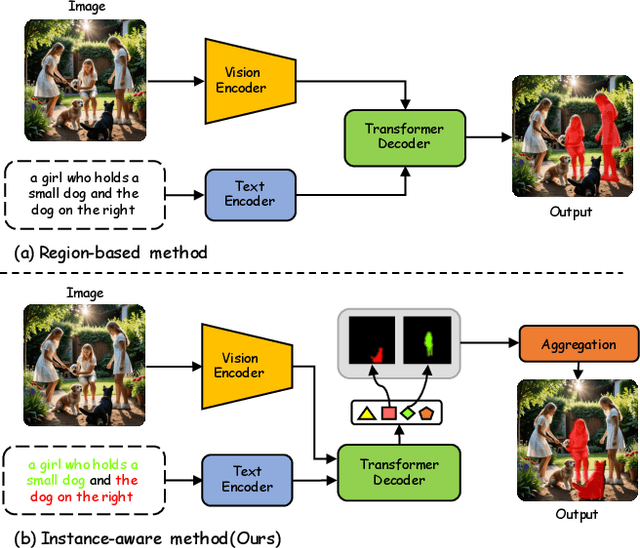
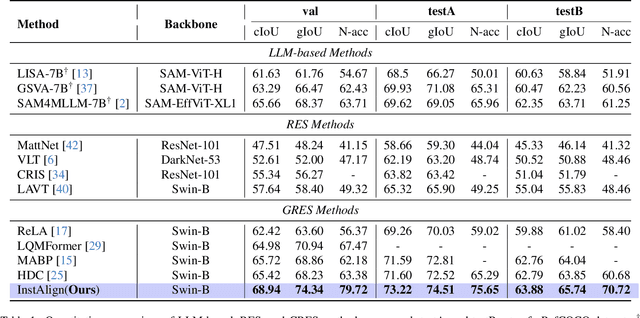

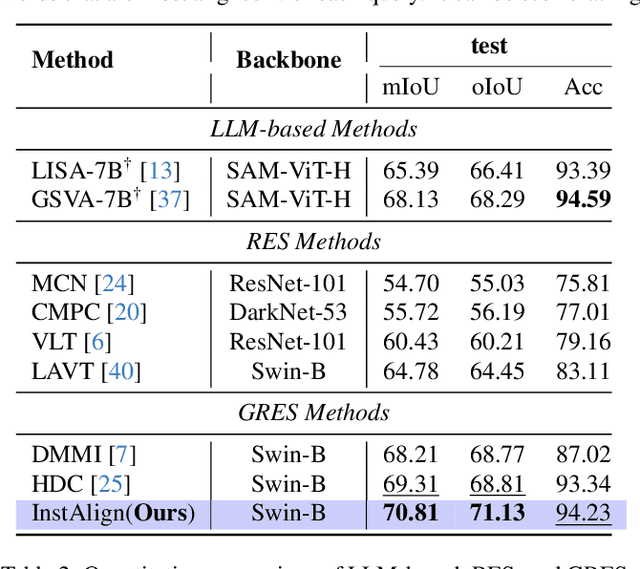
Abstract:Recent works on Generalized Referring Expression Segmentation (GRES) struggle with handling complex expressions referring to multiple distinct objects. This is because these methods typically employ an end-to-end foreground-background segmentation and lack a mechanism to explicitly differentiate and associate different object instances to the text query. To this end, we propose InstAlign, a method that incorporates object-level reasoning into the segmentation process. Our model leverages both text and image inputs to extract a set of object-level tokens that capture both the semantic information in the input prompt and the objects within the image. By modeling the text-object alignment via instance-level supervision, each token uniquely represents an object segment in the image, while also aligning with relevant semantic information from the text. Extensive experiments on the gRefCOCO and Ref-ZOM benchmarks demonstrate that our method significantly advances state-of-the-art performance, setting a new standard for precise and flexible GRES.
 Add to Chrome
Add to Chrome Add to Firefox
Add to Firefox Add to Edge
Add to Edge